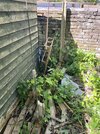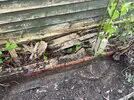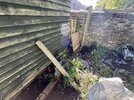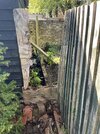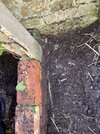I need to reinstate my rear garden fence. The original appears to have been done with concrete posts, six feet apart, and then a couple of courses of bricks between them, acting like a gravel board. It was probably a nice job back in the day but the concrete posts have blown and mostly collapsed, from the rusting-out of the steels inside them.
In an ideal world, I’d somehow dig out the remnants of the posts and slip in some new ones, without destroying the wall in the process, however I’m concerned that I won’t be able to get enough new concrete around the new posts, if they are replaced in-situ. What's the approach here? (other than just building a new fence on the other side of the brick coarse!
In an ideal world, I’d somehow dig out the remnants of the posts and slip in some new ones, without destroying the wall in the process, however I’m concerned that I won’t be able to get enough new concrete around the new posts, if they are replaced in-situ. What's the approach here? (other than just building a new fence on the other side of the brick coarse!


